Samsung Electronics Co LASERMFP1600N Multi Function Printer User Manual 1600n
Samsung Electronics Co Ltd Multi Function Printer 1600n
Contents
- 1. Users Manual 1
- 2. Users Manual 2
Users Manual 2

Maintenance 159
The Phonebook Tab
Click the Phonebook tab to create and edit Phonebook entries.
The Scan Settings Tab
Click the Scan Settings tab to configure the scan destination list that appears on the
operator panel display when you press <Select Software> on the operator panel. Using the
destination list, you can select a software program that an image can be scanned to.
Reads the Phonebook
entries from the
machine to the Printer
Settings Utility.
Downloads the
Phonebook entries
from the Printer
Settings Utility to the
machine. Phonebook entries
Deletes all
Phonebook entries.
Allows you to edit
a selected
Phonebook entry
in a separate Edit
window.
Deletes a selected
Phonebook entry.
Select the program you
want from the Available
Scan Destinations and
click to add it to the
Front Panel Destination
List.
To delete the selected
program, click .
Click to send the list you
add to the machine.
Click to restore
the default
settings.
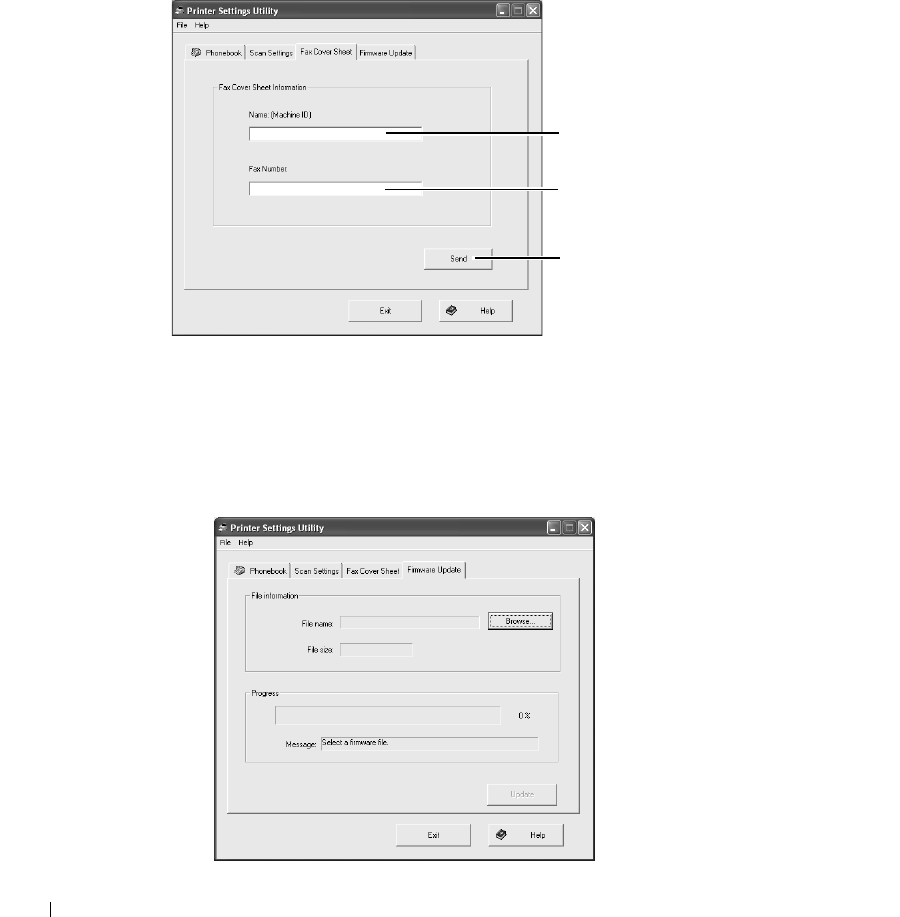
160 Maintenance
The Fax Cover Sheet Tab
Click the Fax Cover Sheet tab to create a fax cover page. When you send a fax, you can
send a cover page together. For details, see page 139. The fax cover page contains the date,
the sender’s fax number and machine ID, the recipient’s fax number and machine ID and
the total number of pages you sent.
The Firmware Update Tab
Click the Firmware Update tab to update the firmware of your machine. This feature
should be used by an authorized technician. Please consult with the purchase point.
Enter your fax number.
Enter the machine ID
you set.
Click to send this cover
page to the machine.
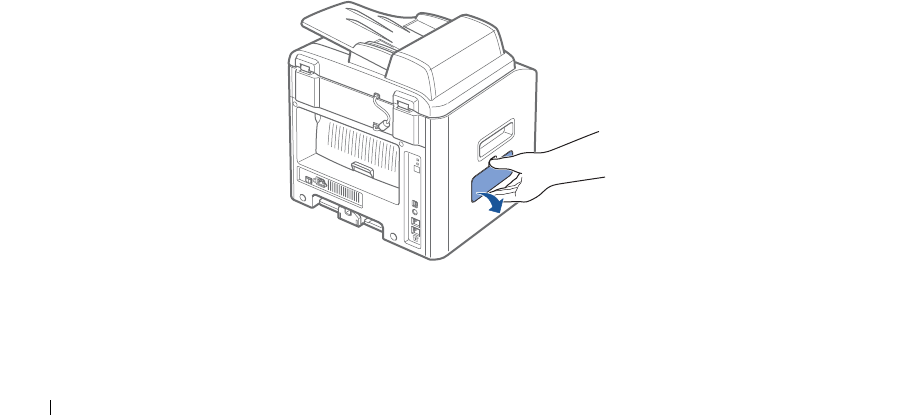
186 Installing Options
Precautions When Installing Machine Options
DISCONNECTING THE POWER CORD:
Never remove the control board while the printer is plugged in.
To avoid the possibility of an electrical shock, always disconnect the power cord when
installing or removing ANY internal or external printer option.
DISCHARGE OF STATIC ELECTRICITY:
The control board and internal printer memory are sensitive to static electricity. Before
installing or removing an internal printer memory, discharge static electricity from your
body by touching something metal on any device plugged into a grounded power source.
If
you walk around before finishing installation,
discharge any static electricity once again.
Installing Printer Memory
Additional printer memory option is provided on Dual In-line Memory Module (DIMM).
This procedure is applicable to either option.
1Turn the printer off and unplug all cables from the printer.
2To remove the control board cover, pull out gently, as shown.
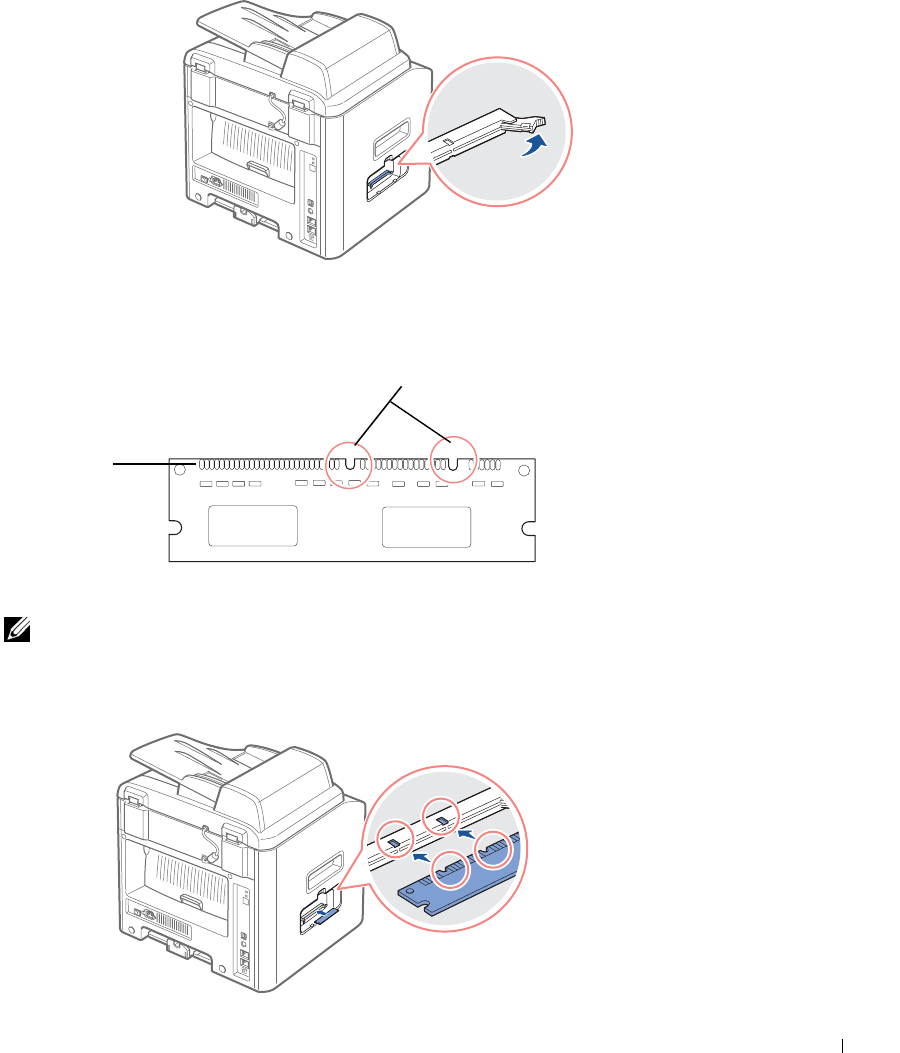
Installing Options 187
3Open the lever on each side of the DIMM slots completely.
4Remove the memory DIMM from the antistatic package. Locate the alignment
notches on the bottom edge of the DIMM.
NOTE: Avoid touching the connection points along the edge of the memory.
5Hold the memory DIMM. Align the notches on the DIMM with the notches at the
top of the DIMM slot.
Notc
h
es
Connection
points
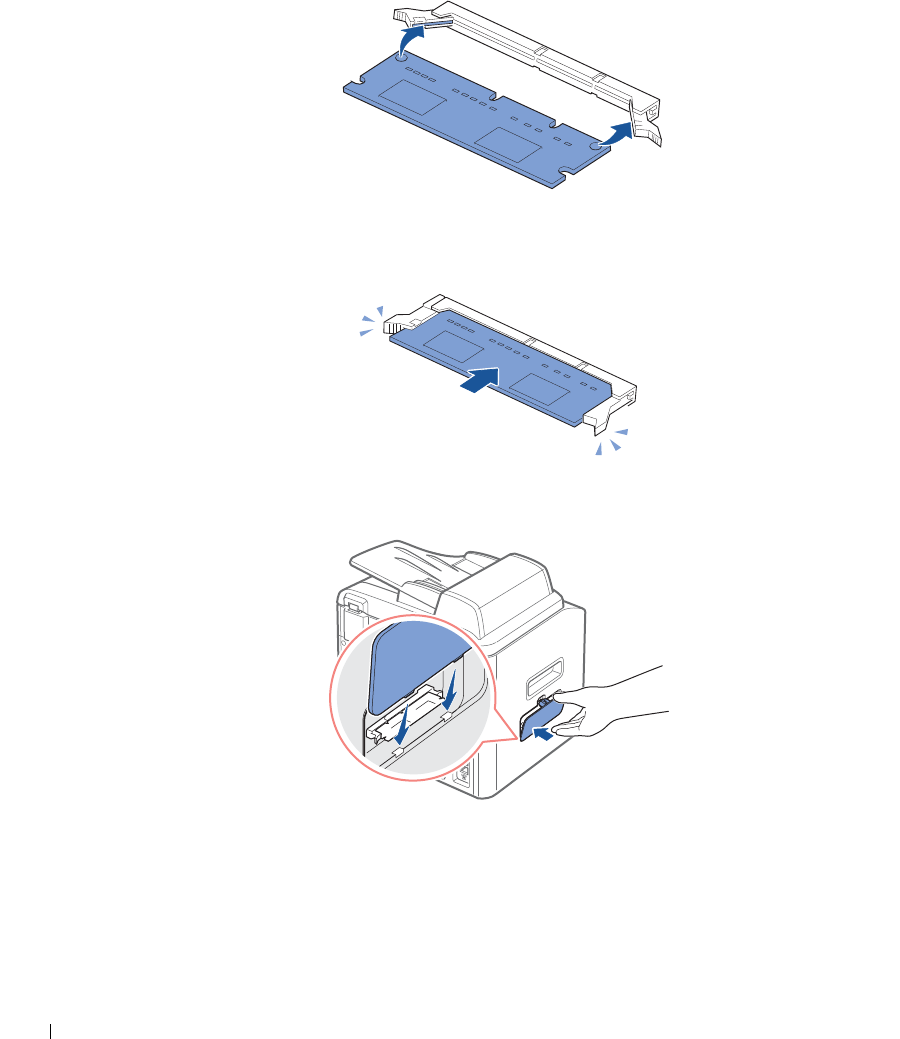
188 Installing Options
6Insert the ends of the memory DIMM into the slot on the levers.
7Push the memory DIMM firmly in to make sure you fully insert it into the slot.
8Replace the control board cover, as shown.
9Reconnect the power cord and printer cable, and turn the printer on.
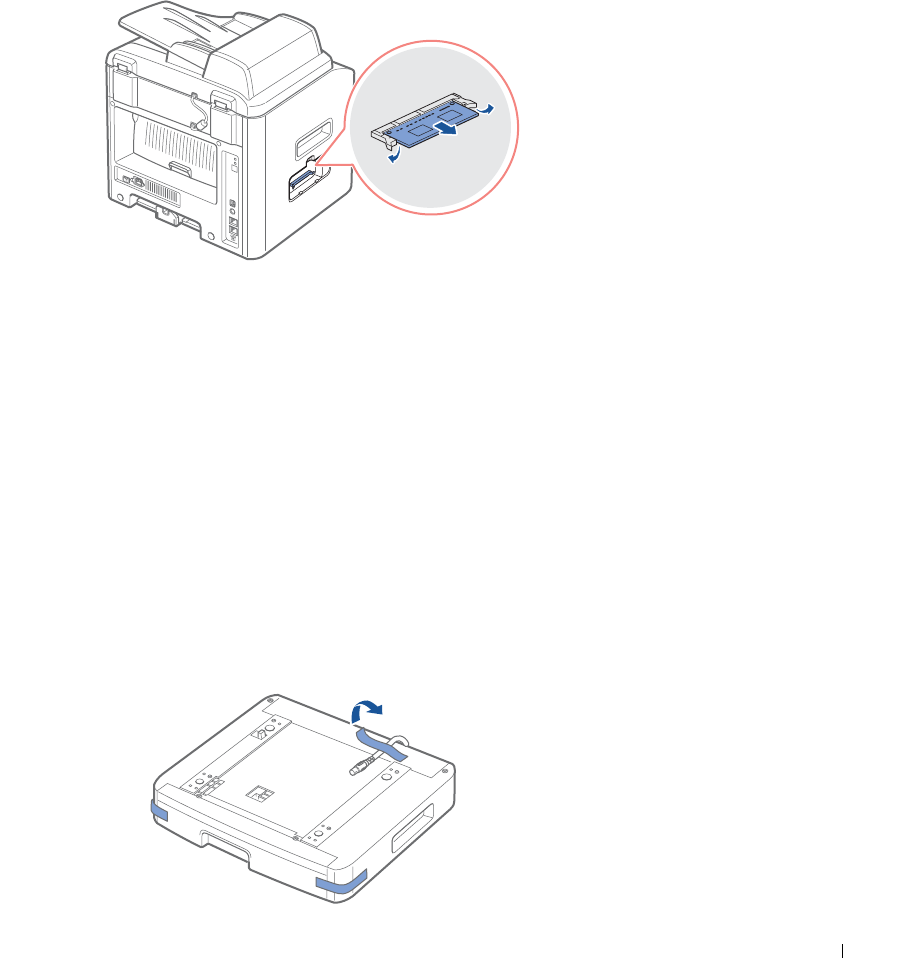
Installing Options 189
Removing the Memory
1Follow steps 1 and 2 on page 186 to access the control board.
2Push the levers at both ends of the DIMM slot away from the DIMM.
3Place the DIMM in its original packaging or wrap it with paper and store it in a box.
4Follow from step 8 on page 188.
Installing an Optional Tray2
You can increase the paper handling capacity of your machine by installing an optional
Tray2. This tray holds 250 sheets of paper.
1Turn the machine off and unplug all cables from the machine.
2Remove the packing tape and the tape fastening the interface cable from the bottom
of the optional Tray2.
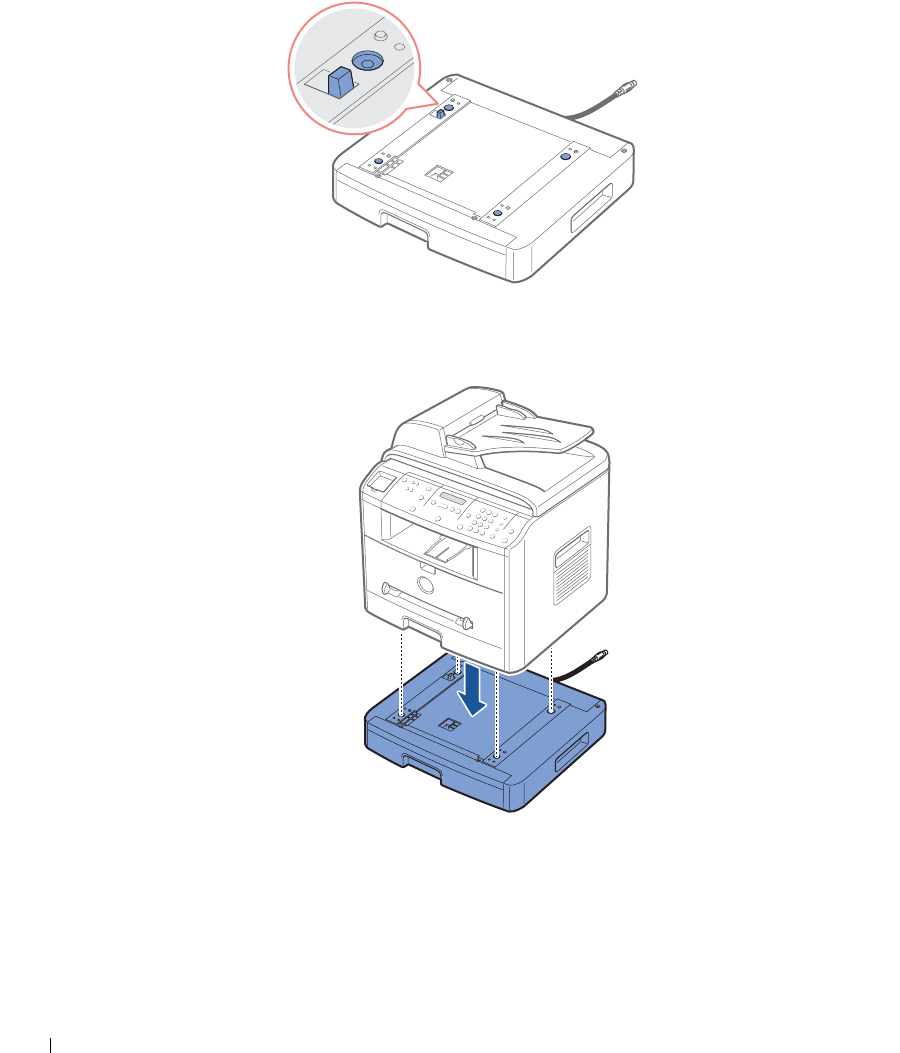
190 Installing Options
3Find the location of the connector and the optional tray positioners.
4Place the machine over the tray, aligning the feet on the machine with the positioners
in the optional Tray2.
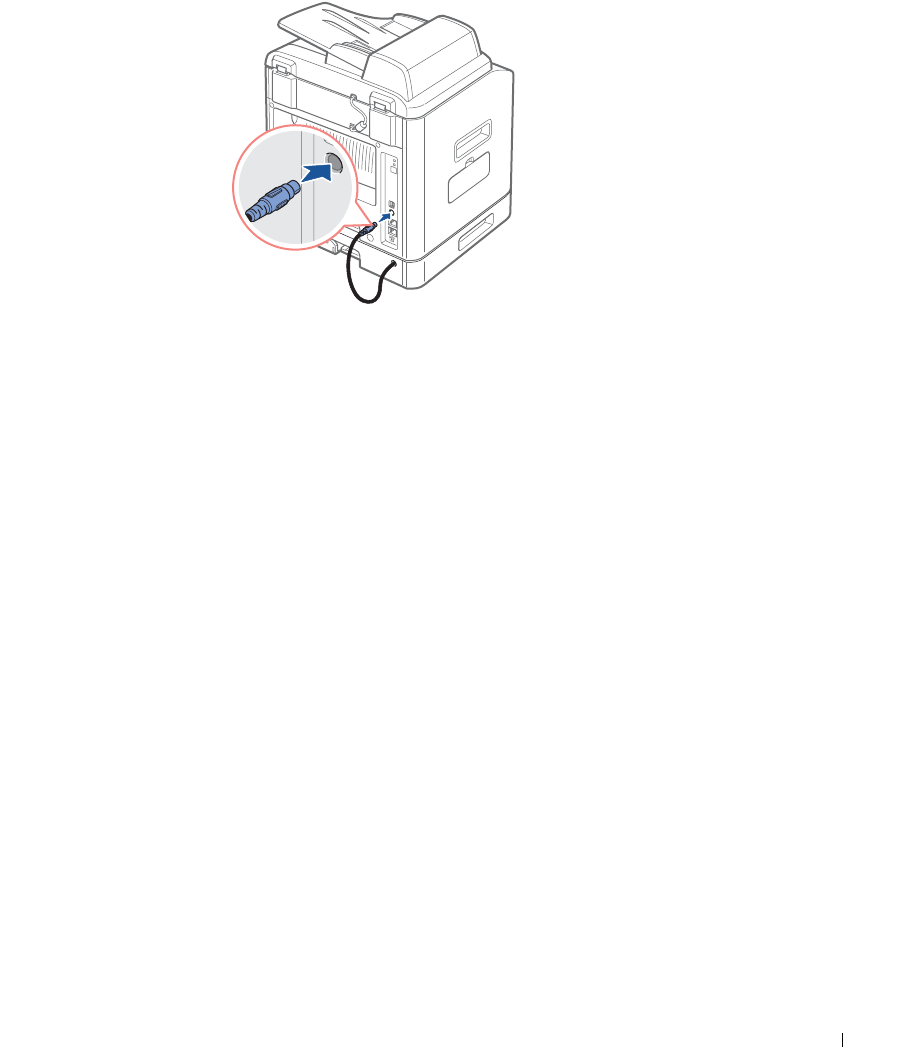
Installing Options 191
5Plug the cable into the connector on the back of the machine.
6Load paper in the optional Tray 2. For information about loading paper in this tray, see
page 17.
7Reconnect the power cord and cables and then turn the machine on.
When you print a document on paper loaded in the optional Tray 2, you must configure the
properties of the printer driver.
To access the properties of the printer driver:
1Click the Windows Start button.
2For Windows 98/Me/NT 4.0/2000, click Settings and point to Printers.
For Windows XP, click Printers and Faxes.
3Click the Dell Laser MFP 1600n printer.
4Right-click the printer icon and:
In Windows 98/Me, click Properties.
In Windows 2000, click Print Setup or click Properties and then point to Printing
Preferences.
In Windows NT 4.0, click Document Default.
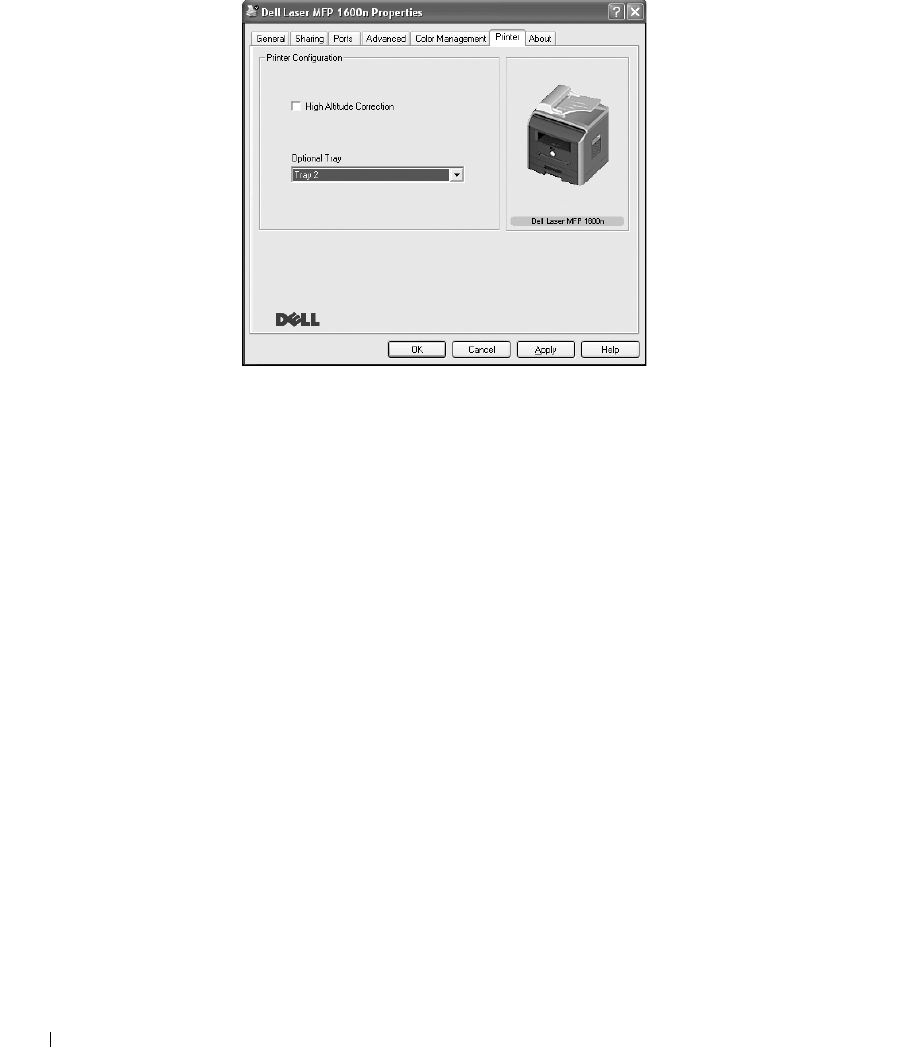
192 Installing Options
5Click the Printer tab, and select Tray 2 from the Optional Tray drop-down list.
6Click OK and print the document.

202 Specifications
General Specifications
Item Description
Automatic document feeder Up to 50 sheets (20 lb, 75g/m2)
ADF Document size Width: 5.6-8.5in. (142-216 mm)
Length: 5.8-14in. (148-356 mm)
Paper input capacity Paper tray: 250 sheets (weight: 17-24 lb)
Bypass tray: 1 sheets (weight: 16-43 lb)
Paper output capacity Front output tray: 150 sheets (face down)
Rear output slot: 1 sheet (face up)
Paper type Paper tray: Plain paper (60-90 g/m2, 16- 24 lb)
Bypass tray: Plain paper, Transparencies, Labels, Card, Post card,
Envelopes (60-120 g/m2, 16-32 lb)
Consumables 1-piece toner cartridge system
Power requirements 100-127 VAC, 50/60 Hz, 4.5A
220-240 VAC, 50/60 Hz, 2.5A
Power consumption Sleep mode: 20 W Energy Star Compliant
Average: 350 W
Noise Copy: 55 dB
Standby mode: 39 dB
Printing: 51 dB
Warm-up Time Less than 42 seconds
Operating conditions Temperature: 50oF-89oF (10oC-32oC)
Humidity: 20%-80% RH
LCD 16 characters x 2 lines
Toner cartridge life 5,000 pages (for starter, 3,000 pages) @ IDC 5% coverage
SET dimension
(W x D x H)
17.7 x 16.7 x 18in.
(450 x 423 x 456 mm)
Random Access Memory
(RAM)
Standard 32MB
Expandable to 160 MB: SDRAM
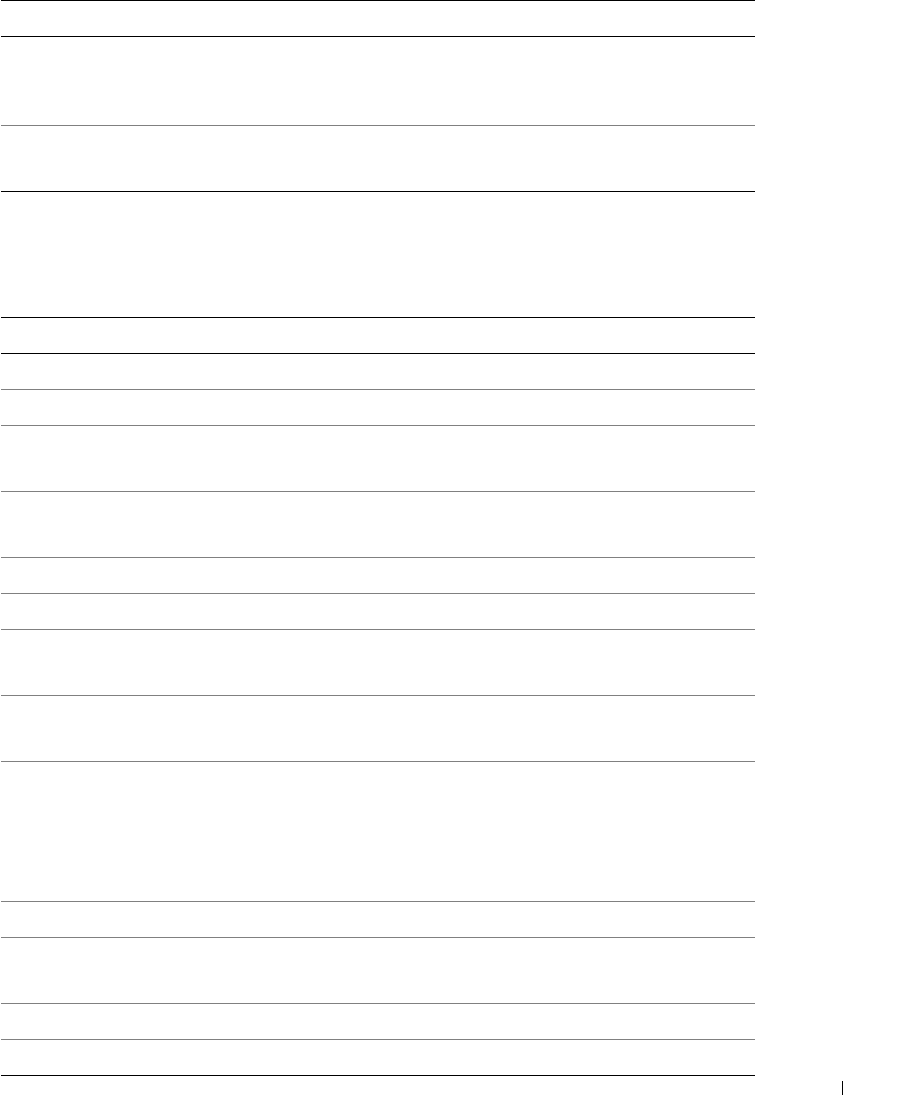
Specifications 203
Scanner and Copier Specifications
Weight Net: 15.6Kg (including toner cartridge), 14.8Kg (except toner
cartridge)
Gross: 20.4Kg(including consumables, accessories and package)
Package Weight Paper: 2.7Kg
Plastic: 0.7Kg
Item Description
Compatibility TWAIN standard
Scanning method Color CCD (Charge Coupled Device) module
Resolution Optical: 600 x 1200 dpi
Enhanced: 4,800 x 4800 dpi
Effective scanning length Platen: 11.5 in. (293 mm)
ADF: 14in. (356 mm)
Effective scanning width 8.2 in. (208mm)
Color bit depth 24 bit
Mono bit depth 1bit for Lineart
8bit for Gray scale
Scan speed (Text mode) Platen: 20 (Linearity), 64 (Gray), 64 seconds (Color)
ADF: 18 (Linearity), 62 (Gray), 62 seconds (Color)
Copy speed SDMC (Single Document Multiple Copy): 22 cpm (copies per
minute for letter), 20cpm for A4
MDMC (Multi-document Multiple Copy) at Text and Mixed:
14cpm
MDMC at Photo mode: 8cpm
Paper size Letter, A4, Legal, Folio, Executive, A5, A6, B5
Zoom rate Platen: 25%-400%
ADF: 25%-100%
Multiple copies 1-99 pages
Copy mode(=Original Type) Text, Text&Photo, Photo
Item Description
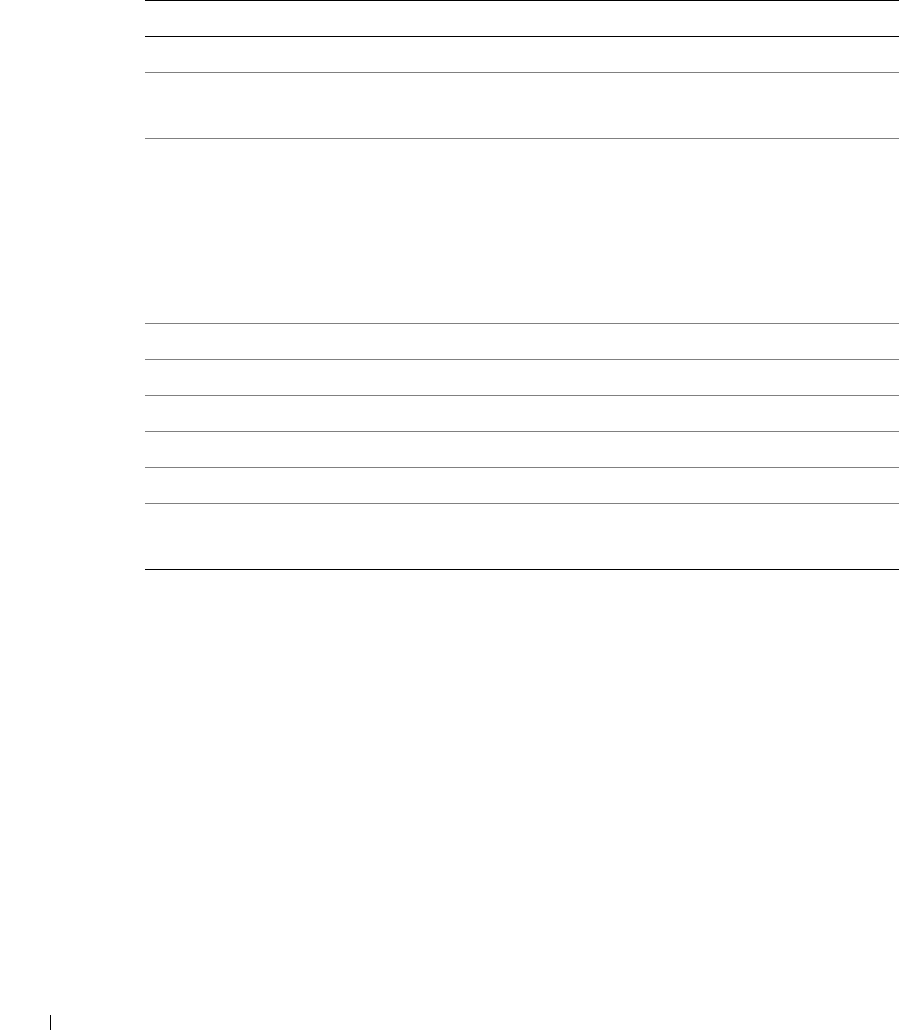
204 Specifications
Printer Specifications
Item Description
Printing method Laser Beam Printing
Printing speed Letter: 22 ppm (pages per minute)
A4: 20 pages per minute
Paper size Paper tray: Letter, A4, Legal, Folio, A5, A6
Bypass tray: Letter, Legal, A4, Folio, Executive, A5, A6, A6 card, Post
Card 4x6, HagaKi, Envelope 7-3/4, Envelope 9, Envelope 10,
Envelope COM-10, Envelope DL, Envelope C5, Envelope C6,
Envelope B5, JIS B5, ISO B5
* Min.: 3 x 5in. (76 x 127 mm)
Max.: 8.5 x 14 in. (216 x 356 mm)
Print resolution 600 x 600 dpi (1200 x 600 dpi)
Emulation GDI, PC6, PCL5e, PostScript Level3
PC Interface USB 2.0 (option)
Network Interface 10/100 Base TX
Compatibility Windows 98/2000/NT 4.0/Me/XP
First printing time Standby mode: 12 seconds
Power save mode: 54 seconds
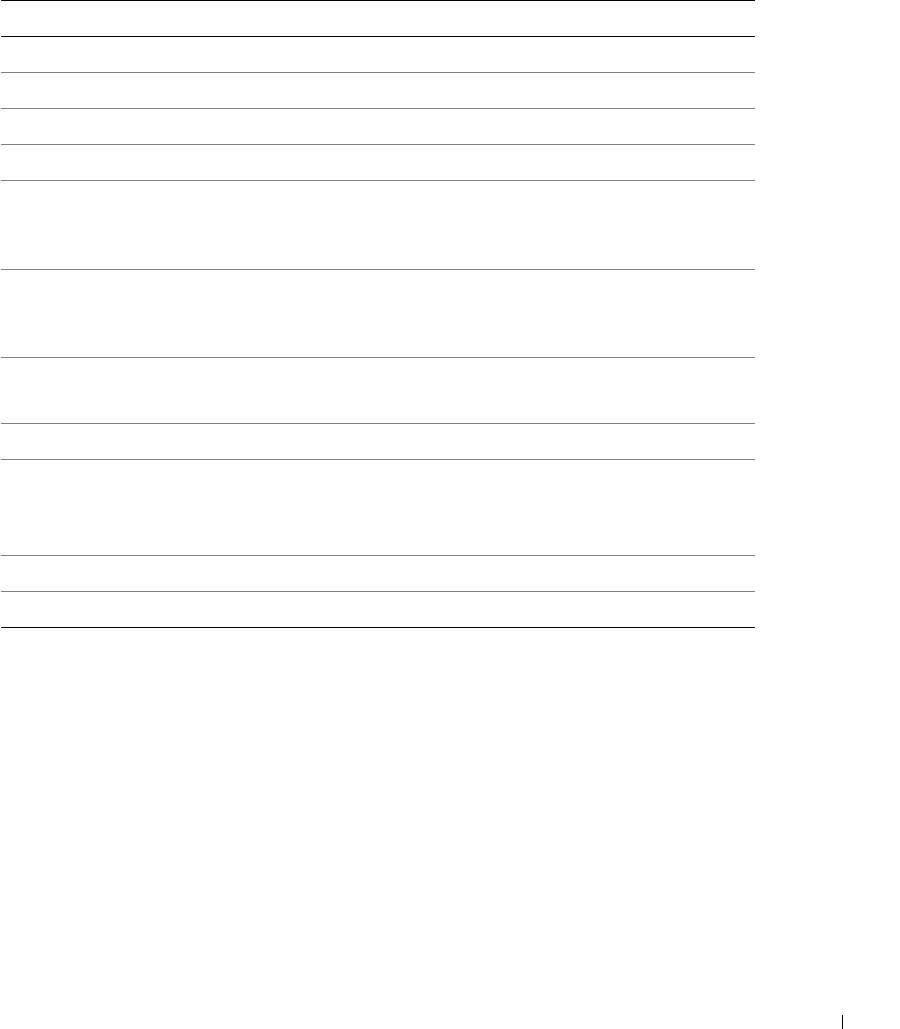
Specifications 205
Facsimile Specifications
Item Description
Compatibility ITU-T Group 3
Applicable line Public Switched Telephone Network (PSTN) or behind PABX
Data coding MH/MR/MMR (ECM Mode) and JPEG for color fax transmission
Modem speed 33.6 Kbps
Transmission speed Approx. 3 seconds/page
* Transmission time applies to memory transmission of text data
with ECM compression using only ITU-T No.1 Chart.
Scanning speed Platen: approx. 6 seconds/A4 (at standard fax resolution mode)
ADF: approx. 2 seconds/Letter (at standard fax resolution mode),
2.5 seconds/Letter (at fine fax resolution mode)
Maximum document length Platen: 297 mm
ADF: 1.5 mm
Paper size Letter, A4, Legal
Resolution Standard: 203 x 98 dpi
Fine: 203 x 196 dpi
Super Fine: 300 x 300 dpi
User Memory 4 MB (320 pages)
Halftone 256 levels

206 Specifications
Paper Specifications
Overview
Your machine accepts a variety of print materials, such as cut-sheet paper (including up to
100 percent recycled fiber content paper), envelopes, labels, transparencies and custom-size
paper. Properties, such as weight, composition, grain and moisture content, are important
factors affecting the machine’s performance and the output quality. Paper that does not
meet the guidelines outlined in this
User’s Guide
can cause the following problems:
• Poor print quality
•Increased paper jams
• Premature wear on the machine.
NOTE: Some paper may meet all of the guidelines in this guide and still not produce
satisfactory results. This may be the result of improper handling, unacceptable temperature and
humidity levels, or other variables over which Dell has no control.
NOTE: Before purchasing large quantities of paper, insure the paper meets the requirements
specified in this
User’s Guide
.
CAUTION: Using paper that does not meet these specifications may cause
problems, requiring repairs. These repairs are not covered by the Dell warranty
or service agreements.
Supported Sizes of Paper
Paper DimensionsaWeight Capacityb
Letter 8.5 X 11in.
(216 X 279 mm) • 60-105 g/m2 bond
(16-28 lb) for the
paper tray
• 60-120 g/m2 bond
(16-32 lb) for the
Bypass tray
• 250 sheets of 75 g/m2 bond (20
lb) paper for the paper tray
• 1 sheet of paper for the Bypass
tray
A4 8.3 X 11.7 in.
(210 X 297 mm)
Executive 7.25 X 10.5in.
(191 X 267 mm)
Legal 8.5 X 14in.
(216 X 356 mm)
Folio 8.5 X 13 in.
(216 X 330 mm)

Specifications 207
NOTE: You may experience jams when using print materials with a length of less than 127 mm
(5inches). For optimum performance, ensure that you are storing and handling the paper
correctly. Please refer to page 209.
Guidelines for Using Paper
For the best result, use conventional 75 g/m
2
(20 lb) paper. Ensure that the paper is of good
quality, and free of cuts, nicks, tears, spots, loose particles, dust, wrinkles, voids, and curled
or bent edges.
If you are unsure of what type of paper you are loading, such as bond or recycled paper,
check the label on the package.
The following problems may cause print quality deviations, jamming or even damage to the
machine:
Minimum size
(custom)
3 x 5in.
(76 x 127 mm) 60-120g/m2
bond (16-32 lb)
1 sheet of paper for the Bypass
tray
Maximum size
(Legal) 8.5 x 14 in.
(216 x 356 mm)
Transparency Same minimum and
maximum paper sizes as
listed above.
138-146 g/m2
Labels 120-150 g/m2
Cards 90-163 g/m2
Envelopes 75-90 g/m2
a. The machine supports a wide range of media sizes.
b. Capacity may vary depending on print materials’ weight and thickness, and environmental
conditions.
Symptom Problem with paper Solution
Poor print quality or toner adhesion,
problems with feeding
Too moist, too rough, too
smooth or embossed; faulty
paper lot
Try another kind of paper,
between 100-400 Sheffied,
4%-5% moisture content.
Dropout, jamming, curl Stored improperly Store paper flat in its
moisture-proof wrapping.
Increased gray background
shading/printer wear
Too heavy Use lighter paper, use the rear
output slot.
Paper DimensionsaWeight Capacityb
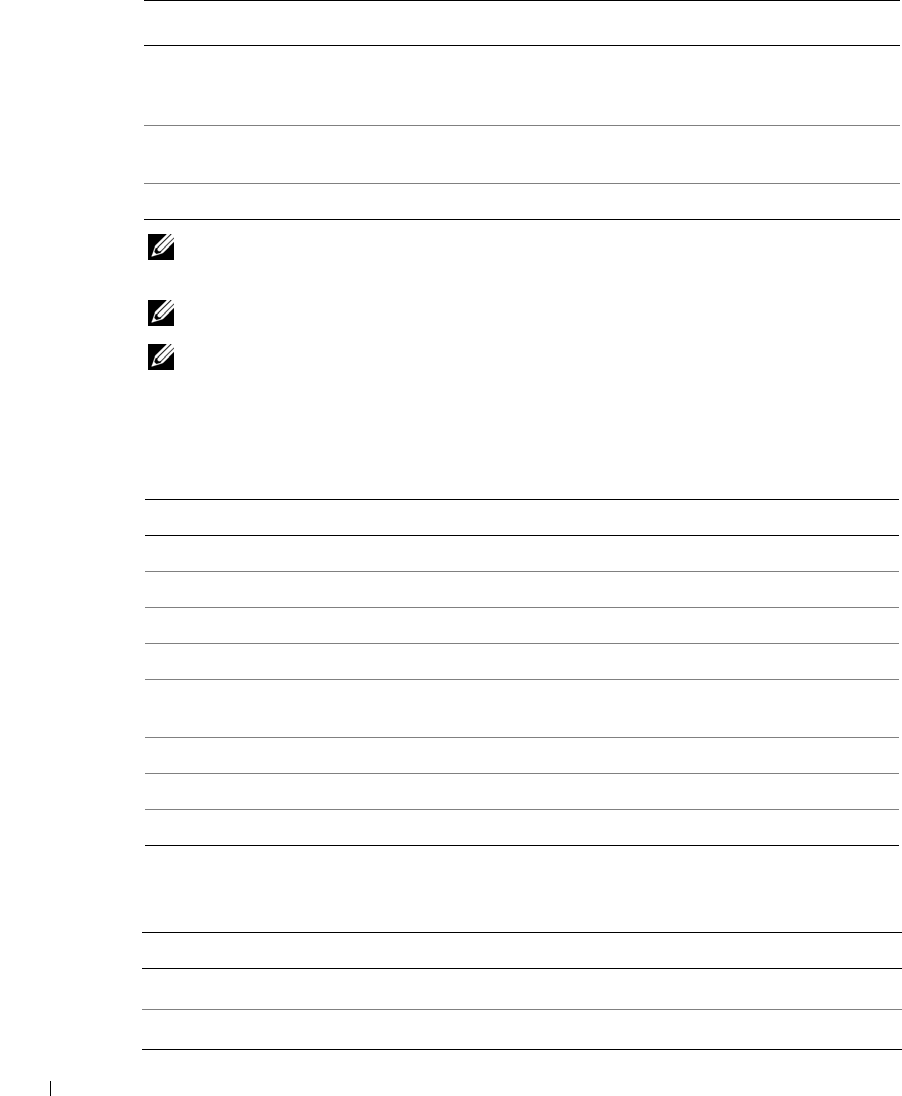
208 Specifications
NOTE: Do not use letterhead paper printed with low-temperature inks, such as those used in
some types of thermography.
NOTE: Do not use raised or embossed letterhead.
NOTE: The machine uses heat and pressure to fuse toner to the paper. Insure that any colored
paper or preprinted forms use inks that are compatible with this fusing temperature (200 °C or
392 °F for 0.1 second).
Paper Specifications
Paper Output Capacity
Excessive curl problems with
feeding
Too moist, wrong grain
direction or short-grain
construction
• Use the rear output slot.
• Use long-grain paper.
Jamming, damage to machine Cutouts or perforations Do not use paper with cutouts
or perforations.
Problems with feeding Ragged edges Use good quality paper.
Category Specifications
Acid Content 5.5 pH or lower
Caliper 0.094-0.18 mm (3.0-7.0 mils)
Curl in Ream Flat within 0.02 in. (5 mm)
Cut Edge Conditions Cut with sharp blades with no visible fray.
Fusing Compatibility Must not scorch, melt, offset or release hazardous emissions when
heated to 200°C (392°F) for 0.1 second.
Grain Long Grain
Moisture Content 4%-6% by weight
Smoothness 100-400 Sheffied
Output Location Capacity
Frint Output Tray (Face Down) 150 sheets of 75 g/m2 bond (20 lb) paper
Rear Output Slot (Face Up) 1 sheet of 75 g/m2 bond (20 lb) paper
Symptom Problem with paper Solution

Specifications 209
Printer and Paper Storage Environment
Paper storage environmental conditions directly affect the feed operation.
Ideally, the machine and paper storage environment should be at or near room temperature,
and not too dry or humid. Remember that paper is hygroscopic; it absorbs and loses
moisture rapidly.
Heat works with humidity to damage paper. Heat causes the moisture in paper to evaporate,
while cold causes it to condense on the sheets. Heating systems and air conditioners remove
most of the humidity from a room. As paper is opened and used, it loses moisture, causing
streaks and smudging. Humid weather or water coolers can cause the humidity to increase
in a room. As paper is opened and used it absorbs any excess moisture, causing light print
and dropouts. Also, as paper loses and gains moisture it can become distorted. This can
cause paper jams.
Care should be taken not to purchase more paper than can be used in a short time (about 3
months). Paper stored for long periods may experience heat and moisture extremes, which
can cause damage. Planning is important to prevent damage to large supplies of paper.
Unopened paper in sealed reams can remain stable for several months before use. Opened
packages of paper have more potential for environment damage, especially if they are not
wrapped with a moisture-proof barrier.
The paper storage environment should be properly maintained to ensure optimum
performance. The required condition is 20°C to 24°C (68°F to 75°F), with a relative
humidity of 4 percent to 55percent. The following guidelines should be considered when
evaluating the paper’s storage environment:
• Paper should be stored at or near room temperature.
• The air should not be too dry or too humid.
• The best way to store an opened ream of paper is to rewrap it tightly in its
moisture-proof wrapping. If the machine environment is subject to extremes, unwrap
only the amount of paper to be used during the day’s operation to prevent unwanted
moisture changes.

210 Specifications

211
Regulatory Notices
COMMENT: This is an all-inclusive boilerplate. Check with your EMC regulatory and safety
contacts to verify that all of these statements apply to your product. Remove any statements
that do not apply, as directed by your EMC regulatory and safety contacts.
COMMENT: Trademarks used in this boilerplate: Dell and ENERGY STAR
COMMENT: CLIENT WRITERS: The only regulatory notices required in English paper
documents are the first three paragraphs of the following introduction (including the paragraph
that starts with "If necessary ... ") and the NOM section. After the third paragraph, include the
following two sentences, ensuring that you verify the cross-reference and update the XXX: "For
additional regulatory information, see the Tell Me How help file that accompanied your
computer. To access the help file, see XXX." The reference will generally be either to the Tell Me
How help file (Inspiron and Dimension) or an online User’s Guide (Latitude, Precision, and
OptiPlex). Or if the computer only comes with one operating system, you could instruct the
user what to click.
Electromagnetic Interference (EMI) is any signal or emission, radiated in free space or conducted along power or signal leads, that
endangers the functioning of a radio navigation or other safety service or seriously degrades, obstructs, or repeatedly interrupts a licensed
radio communications service. Radio communications services include but are not limited to AM/FM commercial broadcast, television,
cellular services, radar, air-traffic control, pager, and Personal Communication Services (PCS). These licensed services, along with
unintentional radiators such as digital devices, including computers, contribute to the electromagnetic environment.
Electromagnetic Compatibility (EMC) is the ability of items of electronic equipment to function properly together in the electronic
environment. While this computer has been designed and determined to be compliant with regulatory agency limits for EMI, there is no
guarantee that interference will not occur in a particular installation. If this equipment does cause interference with radio
communications services, which can be determined by turning the equipment off and on, you are encouraged to try to correct the
interference by one or more of the following measures:
• Reorient the receiving antenna.
• Relocate the computer with respect to the receiver.
• Move the computer away from the receiver.
• Plug the computer into a different outlet so that the computer and the receiver are on different branch circuits.
If necessary, consult a Dell Technical Support representative or an experienced radio/television technician for additional suggestions.
Dell™ computers are designed, tested, and classified for their intended electromagnetic environment. These electromagnetic
environment classifications generally refer to the following harmonized definitions:
COMMENT: CLIENT WRITERS: Always verify with your Regulatory engineer whether your
platform is Class A or Class B. If your Regulatory engineer confirms that your platform is Class
B only, you can delete all references to Class A in this boilerplate.
• Class A is typically for business or industrial environments.
• Class B is typically for residential environments.

212
Information Technology Equipment (ITE), including devices, expansion cards, printers, input/output (I/O) devices, monitors, and so on,
that are integrated into or connected to the computer should match the electromagnetic environment classification of the computer.
A Notice About Shielded Signal Cables: Use only shielded cables for connecting devices to any Dell device to reduce the possibility of
interference with radio communications services. Using shielded cables ensures that you maintain the appropriate EMC classification
for the intended environment. For parallel printers, a cable is available from Dell. If you prefer, you can order a cable from Dell on the
World Wide Web at accessories.us.dell.com/sna/category.asp?category_id=4117.
Most Dell computers are classified for Class B environments. However, the inclusion of certain options can change the rating of some
configurations to Class A. To determine the electromagnetic classification for your computer or device, see the following sections
specific for each regulatory agency. Each section provides country-specific EMC/EMI or product safety information.
FCC Notices (U.S. Only)
Most Dell computers are classified by the Federal Communications Commission (FCC) as Class B digital devices. To determine which
classification applies to your computer, examine all FCC registration labels located on the bottom, side, or back panel of your computer,
on card-mounting brackets, and on the cards themselves. If any one of the labels carries a Class A rating, your entire computer is
considered to be a Class A digital device. If
all
labels carry an FCC Class B rating as distinguished by either an FCC ID number or the
FCC logo, ( ), your computer is considered to be a Class B digital device.
Once you have determined your computer’s FCC classification, read the appropriate FCC notice. Note that FCC regulations provide
that changes or modifications not expressly approved by Dell could void your authority to operate this equipment.
This device complies with Part 15 of the FCC Rules. Operation is subject to the following two conditions:
• This device may not cause harmful interference.
• This device must accept any interference received, including interference that may cause undesired operation.
Class A
This equipment has been tested and found to comply with the limits for a Class A digital device pursuant to Part 15 of the FCC Rules.
These limits are designed to provide reasonable protection against harmful interference when the equipment is operated in a
commercial environment. This equipment generates, uses, and can radiate radio frequency energy and, if not installed and used in
accordance with the manufacturer’s instruction manual, may cause harmful interference with radio communications. Operation of this
equipment in a residential area is likely to cause harmful interference, in which case you will be required to correct the interference at
your own expense.
Class B
This equipment has been tested and found to comply with the limits for a Class B digital device pursuant to Part 15 of the FCC Rules.
These limits are designed to provide reasonable protection against harmful interference in a residential installation. This equipment
generates, uses, and can radiate radio frequency energy and, if not installed and used in accordance with the manufacturer’s instruction
manual, may cause interference with radio communications. However, there is no guarantee that interference will not occur in a
particular installation. If this equipment does cause harmful interference to radio or television reception, which can be determined by
turning the equipment off and on, you are encouraged to try to correct the interference by one or more of the following measures:
• Reorient or relocate the receiving antenna.
• Increase the separation between the equipment and the receiver.
• Connect the equipment into an outlet on a circuit different from that to which the receiver is connected.
• Consult the dealer or an experienced radio/television technician for help.

213
FCC Identification Information
COMMENT: Add the regulatory model number as appropriate for your computer in the
following bulleted list.
The following information is provided on the device or devices covered in this document in compliance with FCC regulations:
• Model number:
• Company name:
Dell Inc.
One Dell Way
Round Rock, Texas 78682 USA
512-338-4400
COMMENT: The following modem information is only applicable for products with onboard
modems, not add-in modem PCMCIA cards.
Modem Regulatory Information
This equipment complies with Part 68 of the FCC Rules. On the bottom of your computer is a label that contains, among other
information, the FCC registration number and ringer equivalence number (REN) for your equipment. If requested, you must provide
this information to the telephone company.
The REN is used to determine the quantity of devices that may be connected to the telephone line. Excessive RENs on the telephone
line may result in the devices not ringing in response to an incoming call. In most areas, the sum of all the RENs on your telephone line
should be less than five to ensure proper service from the telephone company. To be certain of the number of devices that you may
connect to a line, as determined by the total RENs, contact your local telephone company.
The registration jack Universal Service Order Code (USOC) used by this equipment is RJ-11C. An FCC compliant telephone cord and
modular plug is provided with this equipment. This equipment is designed to be connected to the telephone network or premises wiring
using a compatible modular jack that is Part 68 compliant.
This equipment cannot be used on public coin-phone service provided by the telephone company. Connection to party line service is
subject to state tariffs.
There are no user serviceable parts on the modem contained in your computer.
If your telephone equipment causes harm to the telephone network, the telephone company will notify you in advance that service may
be temporarily discontinued. If advance notice is not practical, the telephone company will notify you as soon as possible. Also, you will
be advised of your right to file a complaint with the FCC if you believe it is necessary.
The telephone company may make changes in its facilities, equipment, operations, or procedures that could affect the operation of this
equipment. If this happens, the telephone company will provide advance notice in order for you to make necessary modifications to
maintain uninterrupted service.
COMMENT: Verify the accuracy of the cross-reference in the following paragraph.
If you experience trouble with this telephone equipment, see "Getting Help" in your computer's troubleshooting documentation or, for
some computers, the section titled "Contacting Dell" in your computer's online guide to find the appropriate telephone number for
obtaining customer assistance. If the equipment is causing harm to the telephone network, the telephone company may request that you
disconnect the equipment until the problem is resolved.
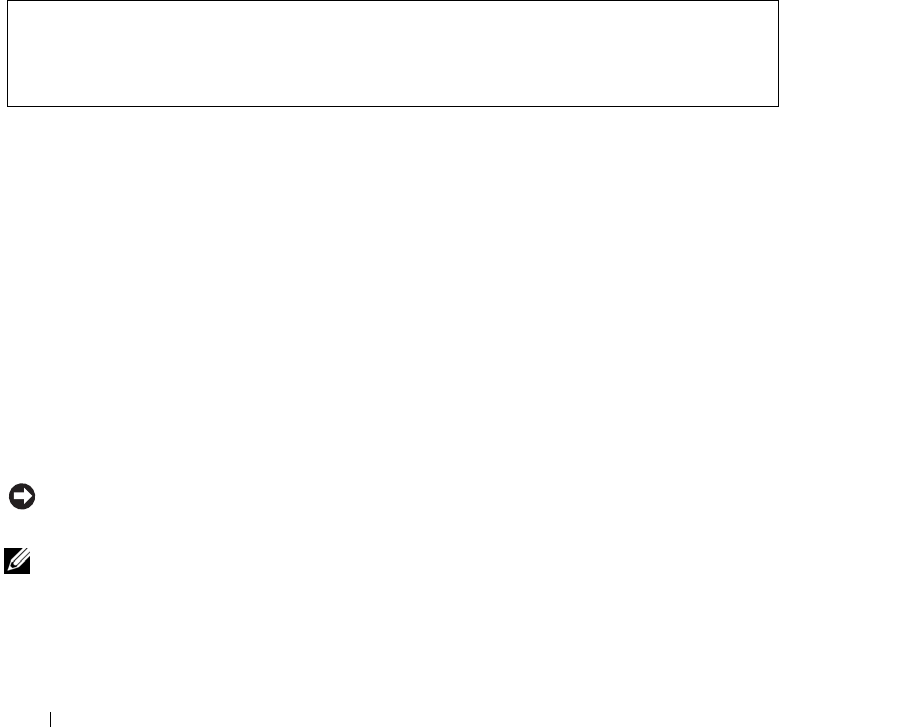
214
Fax Branding
The Telephone Consumer Protection Act of 1991 makes it unlawful for any person to use a computer or other electronic device,
including fax machines, to send any message unless such message clearly contains in a margin at the top or bottom of each transmitted
page or on the first page of the transmission, the date and time it is sent, identification of the business, other entity, or individual
sending the message, and the telephone number of the sending machine or such business, other entity, or individual. The telephone
number provided may not be a 900 number or any other number for which charges exceed local or long-distance transmission charges.
IC Notice (Canada Only)
Most Dell computers (and other Dell digital apparatus) are classified by the Industry Canada (IC) Interference-Causing Equipment
Standard #3 (ICES-003) as Class B digital devices. To determine which classification (Class A or B) applies to your computer (or other
Dell digital apparatus), examine all registration labels located on the bottom, side, or the back panel of your computer (or other digital
apparatus). A statement in the form of "IC Class A ICES-003" or "IC Class B ICES-003" will be located on one of these labels. Note that
Industry Canada regulations provide that changes or modifications not expressly approved by Dell could void your authority to operate
this equipment.
COMMENT: The following modem information is only applicable for products with onboard
modems, not add-in modem PCMCIA cards.
Modem Regulatory Information
The IC label identifies certified equipment. This certification means that the equipment meets telecommunications network protective,
operational, and safety requirements as prescribed in the appropriate Terminal Equipment Technical Requirements document(s). The
IC label does not guarantee that the equipment will operate to the user's satisfaction.
Before installing this equipment, users should ensure that it is permissible to be connected to the facilities of the local
telecommunications company. The equipment must also be installed using an acceptable method of connection. The customer should
be aware that compliance with the above conditions may not prevent degradation of service in some situations.
Repairs to certified equipment should be coordinated by a representative designated by the supplier. Any repairs or alteration made by a
user to this equipment, or equipment malfunctions, may give the telephone communications company cause to request the user to
disconnect the equipment.
Users should ensure for their own protection, that the electrical ground connections of the power utility, telephone lines, and internal
metallic water-pipe system, if present, are connected together. This precaution may be particularly important in rural areas.
NOTICE: Users should not attempt to make such connections themselves. Contact the appropriate electric inspection authority, or
electrician, as appropriate.
NOTE: The REN assigned to each terminal device provides an indication of the maximum number of terminals
allowed to be connected to a telephone interface. The termination on an interface may consist of any combination of
devices subject only to the requirement that the sum of the RENs of all the devices does not exceed the number five.
This Class B (or Class A, if so indicated on the registration label) digital apparatus meets the requirements of the
Canadian Interference-Causing Equipment Regulations.
Cet appareil numérique de la Classe B (ou Classe A, si ainsi indiqué sur l’étiquette d’enregistration) respecte
toutes les exigences du Reglement sur le Materiel Brouilleur du Canada.

215
COMMENT: WRITERS: Verify the "0.6 B" measurement in the following clause with your
Regulatory modem contacts.
The REN for the internal modem as stated on the IC regulatory label located on the bottom of the computer is 0.6 B.
The following information is provided in compliance with IC regulations:
Dell Inc.
One Dell Way
Round Rock, TX 78682 USA
512-338-4400
CE Notice (European Union)
Marking by the symbol indicates compliance of this Dell computer to the EMC Directive and the Low Voltage Directive of the
European Union. Such marking is indicative that this Dell system meets the following technical standards:
• EN 55022 — "Information Technology Equipment — Radio Disturbance Characteristics — Limits and Methods of
Measurement."
• EN 55024 — "Information Technology Equipment - Immunity Characteristics - Limits and Methods of Measurement."
• EN 61000-3-2 — "Electromagnetic Compatibility (EMC) - Part 3: Limits - Section 2: Limits for Harmonic Current Emissions
(Equipment Input Current Up to and Including 16 A Per Phase)."
• EN 61000-3-3 — "Electromagnetic Compatibility (EMC) - Part 3: Limits - Section 3: Limitation of Voltage Fluctuations and
Flicker in Low-Voltage Supply Systems for Equipment With Rated Current Up to and Including 16 A."
• EN 60950 — "Safety of Information Technology Equipment."
NOTE: EN 55022 emissions requirements provide for two classifications:
• Class A is for typical commercial areas.
• Class B is for typical domestic areas.
COMMENT: Include the following warning ONLY for Class A computers/products. Do not
precede it with an icon, and do not change it to a caution.
RF INTERFERENCE WARNING: This is a Class A product. In a domestic environment this product may cause radio frequency
(RF) interference, in which case the user may be required to take adequate measures.
COMMENT: Include the following sentence ONLY for Class B computers/products:
This Dell device is classified for use in a typical Class B domestic environment.
COMMENT: In rare cases, the regulatory engineer may instruct you to keep both the warning
(Class A) and the sentence (Class B) in the same document. When that occurs, precede the RF
INTERFERENCE WARNING for Class A with the following sentence (Enterprise writers, delete
"system information" from the following paragraph): To determine which classification applies
to your computer, examine the FCC or ICES information on the regulatory label located on the
back, side, or bottom panel of the computer. If the FCC or ICES information on the label
indicates a Class A rating, the following Class A warning applies to your computer:
COMMENT: Then precede the Class B statement with the following sentence: If the FCC or
ICES information on the label indicates a Class B rating, the following Class B statement
applies to your computer:
COMMENT: Include the following paragraph, regardless of Class A or Class B certification.
A "Declaration of Conformity" in accordance with the preceding directives and standards has been made and is on file at Dell Inc.
Products Europe BV, Limerick, Ireland.
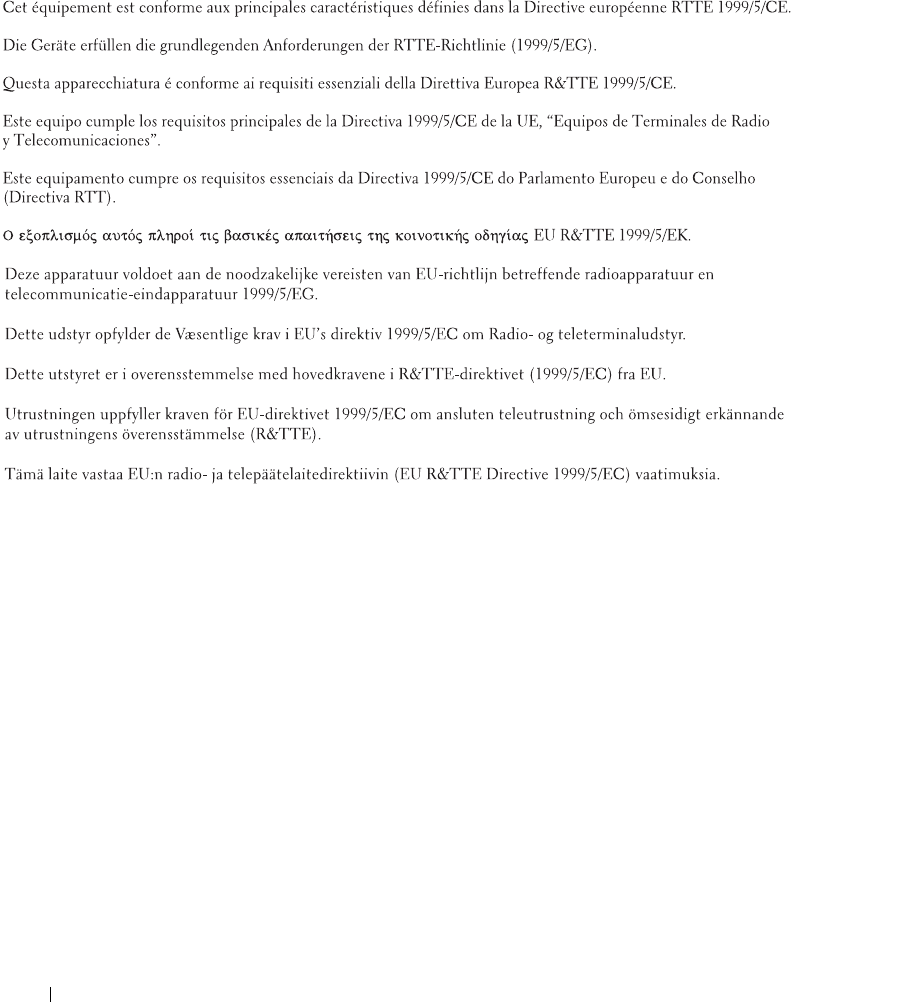
216
CE Mark Notice
This equipment complies with the essential requirements of the European Union Directive 1999/5/EC.
COMMENT: Use the New Zealand Telecom Warnings only in documents for computers that
have modems and are shipping to New Zealand.
New Zealand Telecom Warnings
General
"The grant of a Telepermit for any item of terminal equipment indicates only that Telecom has accepted that the item complies with
minimum conditions for connection to its network. It indicates no endorsement of the product by Telecom, nor does it provide any sort
of warranty. Above all, it provides no assurance that any item will work correctly in all respects with another item of Telepermitted
equipment of a different make or model, nor does it imply that any product is compatible with all of Telecom’s network services."
"This equipment does not fully meet Telecom impedance requirements. Performance limitations may occur when used in conjunction
with some parts of the network. Telecom will accept no responsibility should difficulties arise in such circumstances."
"This equipment shall not be set up to make automatic calls to the Telecom ‘111’ Emergence Service."
"If a charge for local calls is unacceptable, the ‘Dial’ button should NOT be used for local calls. Only the 7-digits of the local number
should be dialed from your telephone. DO NOT dial the area code digit or the ‘0’ prefix."
"This equipment may not provide for the effective hand-over of a call to another device connected to the same line."
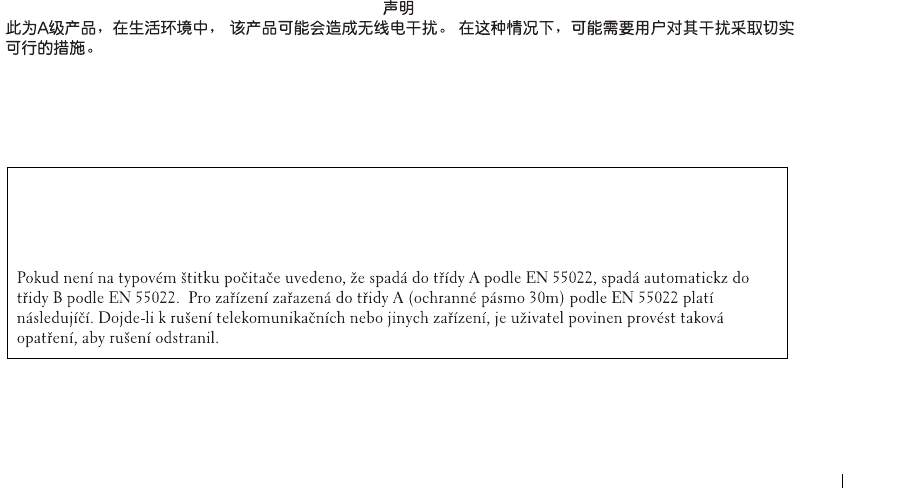
217
Important Notice
"Under power failure conditions, this telephone may not operate. Please ensure that a separate telephone, not dependent on local power,
is available for emergency use."
"Some parameters required for compliance with Telecom’s Telepermit requirements are dependent on the equipment (PC) associated
with this device. The associated equipment shall be set to operate within the following limits for compliance with Telecom’s
Specification:
1
There shall be no more than 10 call attempts to the same number within any 30-minute period for any single manual call initiation,
and the equipment shall go on-hook for a period of not less than 30 seconds between the end of one attempt and the beginning of the
next attempt.
2
Where automatic calls are made to different numbers, the equipment shall go on-line for a period of not less than 5 seconds between
the end of one attempt and the beginning of the next attempt.
3
The equipment shall be set to ensure that calls are answered between 3 and 30 seconds of receipt of ringing."
"All persons using this device for recording telephone conversations shall comply with New Zealand law. This requires that at least one
party to the conversation is to be aware that it is being recorded. In addition, the Principles enumerated in the Privacy Act of 1993 shall
be complied with in respect to the nature of the personal information collected, the purpose for its collection, how it is used and what is
disclosed to any other party."
COMMENT: Do not change the warning in the Simplified Chinese Class A Warning Notice
(China Only) to a caution.
Simplified Chinese Class A Warning Notice (China Only)
On Class A systems, the following warning will appear near the regulatory label:
Warning: This is a Class A product. In a domestic environment this product may cause radio interference, in which case the user may
be required to take adequate measures.
EN 55022 Compliance (Czech Republic Only)
This device belongs to Class B devices as described in EN 55022, unless it is specifically stated that it is a Class A
device on the specification label. The following applies to devices in Class A of EN 55022 (radius of protection up
to 30 meters). The user of the device is obliged to take all steps necessary to remove sources of interference to
telecommunication or other devices.
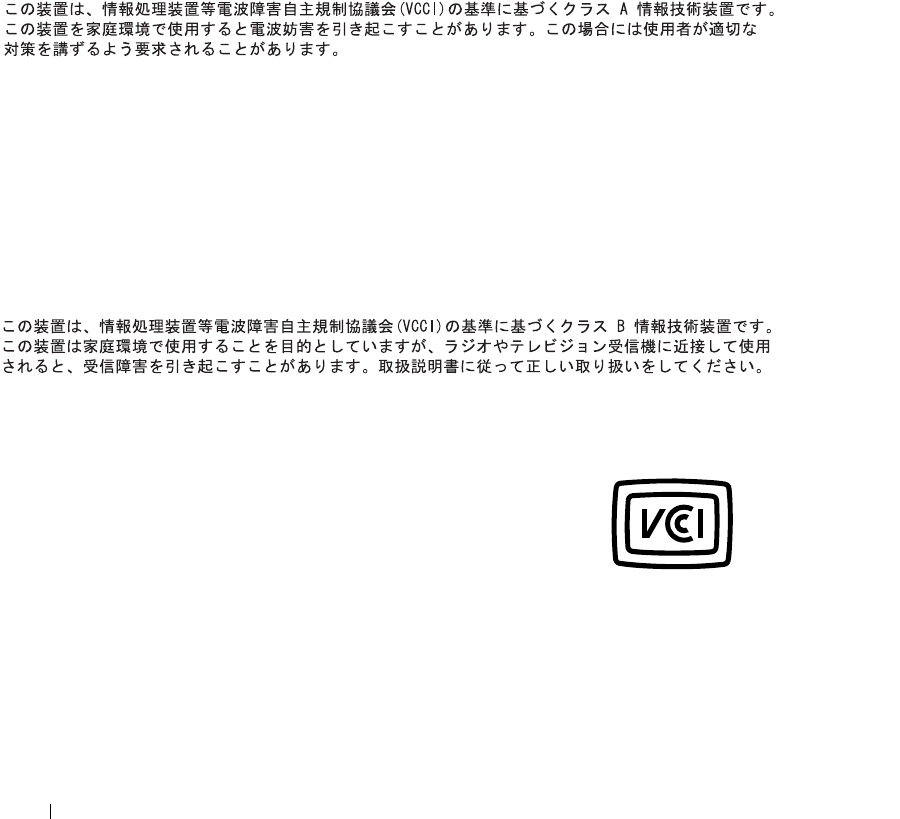
218
VCCI Notice (Japan Only)
Most Dell computers are classified by the Voluntary Control Council for Interference (VCCI) as Class B information technology
equipment (ITE). However, the inclusion of certain options can change the rating of some configurations to Class A. ITE, including
devices, expansion cards, printers, input/output (I/O) devices, monitors, and so on, integrated into or connected to the computer should
match the electromagnetic environment classification (Class A or B) of the computer.
To determine which classification applies to your computer, examine the regulatory labels/markings located on the bottom, side, or back
panel of your computer. Once you have determined your computer’s VCCI classification, read the appropriate VCCI notice (see "VCCI
Class A ITE Regulatory Mark" or "VCCI Class B ITE Regulatory Mark").
Class A ITE
This is a Class A product based on the standard of the Voluntary Control Council for Interference (VCCI) for information technology
equipment. If this equipment is used in a domestic environment, radio disturbance may arise. When such trouble occurs, the user may
be required to take corrective actions.
VCCI Class A ITE Regulatory Mark
If the regulatory label includes the following marking, your computer is a Class A product:
Class B ITE
This is a Class B product based on the standard of the Voluntary Control Council for Interference (VCCI) for information technology
equipment. If this equipment is used near a radio or television receiver in a domestic environment, it may cause radio interference.
Install and use the equipment according to the instruction manual.
VCCI Class B ITE Regulatory Mark
If the regulatory label includes the following marking, your computer is a Class B product:
VCCI
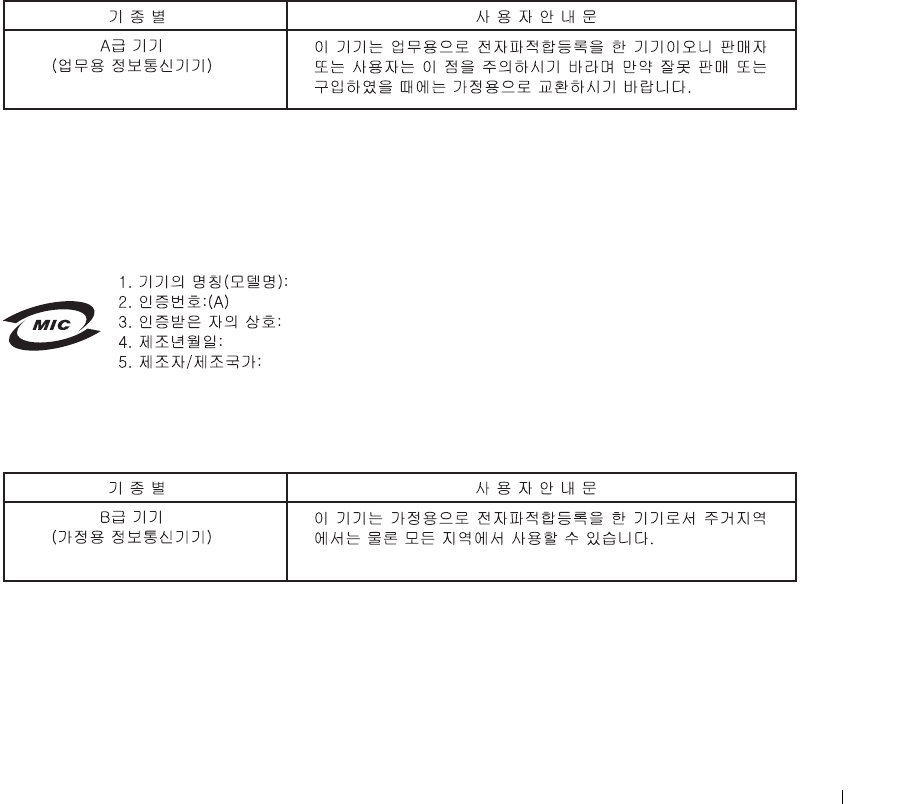
219
MIC notice (Republic of Korea Only)
To determine which classification (Class A or B) applies to your computer (or other Dell digital device), examine the Republic of Korean
Ministry of Information and Communications (MIC) registration labels located on your computer (or other Dell digital device). The
MIC label may be located separately from the other regulatory marking applied to your product. Line two of the label identifies the
emissions class for the product—"(A)" for Class A products or "(B)" for Class B products.
NOTE: MIC emissions requirements provide for two classifications:
• Class A devices are for business purposes.
• Class B devices are for nonbusiness purposes.
Class A Device
Please note that this device has been approved for business purposes with regard to electromagnetic interference. If you find that this
device is not suitable for your use, you may exchange it for a nonbusiness-purpose device.
MIC Class A Regulatory Label
If the regulatory label includes the following marking, your computer is a Class A product:
Class B Device
Please note that this device has been approved for nonbusiness purposes and may be used in any environment, including residential
areas.
COMMENT: The following MIC Class B Regulatory label requires system-specific changes, so
ensure that you check with your EMC engineer about modifying it for your system. (If your
system was manufactured at a Compal or Quanta facility, you can use the graphic in the
"Graphic for MIC Class B" folder for line 5 of the following MIC Class B Regulatory label.) The
regulatory model and marketing name/model will change with every system.
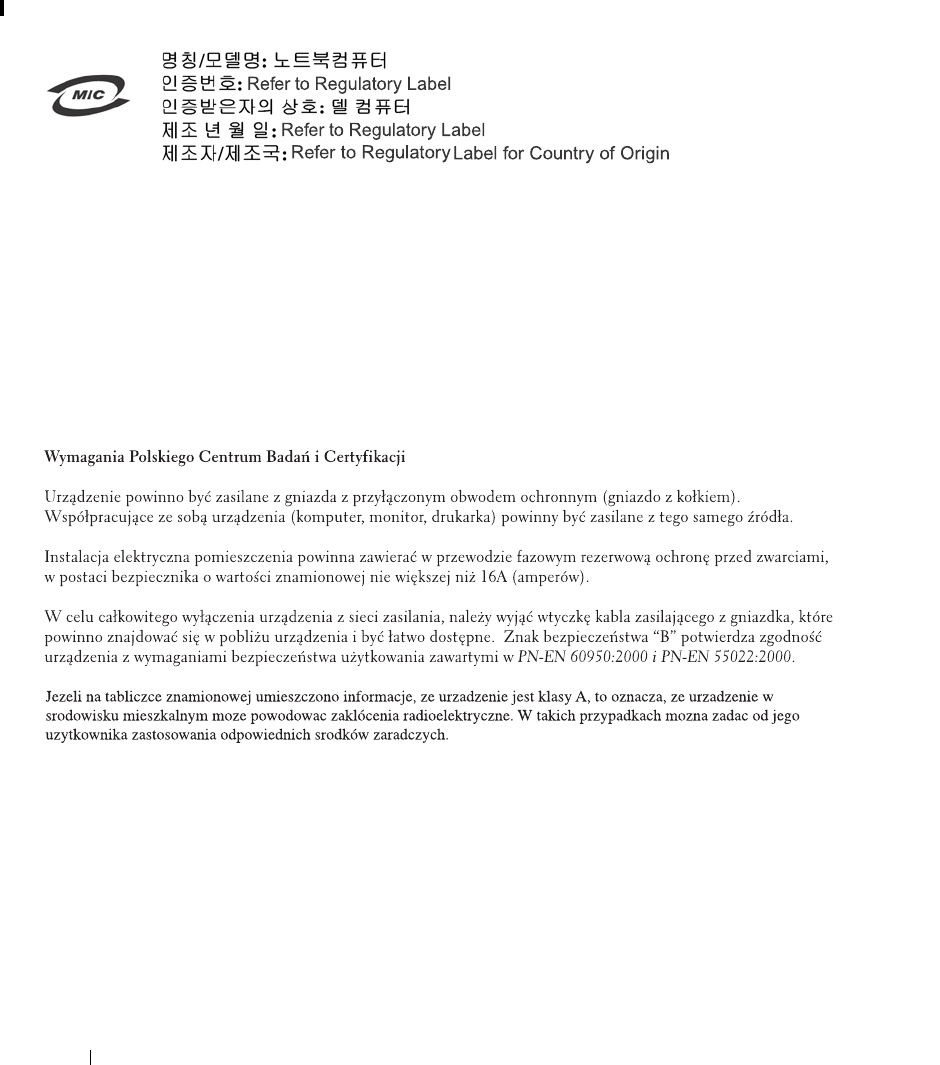
220
MIC Class B Regulatory Label
If the regulatory label includes the following marking, your computer is a Class B product:
Polish Center For Testing And Certification Notice
The equipment should draw power from a socket with an attached protection circuit (a 3-prong socket). All equipment that works
together (computer, monitor, printer, and so on) should have the same power supply source.
The phasing conductor of the room’s electrical installation should have a reserve short-circuit protection device in the form of a fuse
with a nominal value no larger than 16 amperes (A).
To completely switch off the equipment, the power supply cable must be removed from the power supply socket, which should be
located near the equipment and easily accessible.
A protection mark "B" confirms that the equipment is in compliance with the protection usage requirements of standard PN-EN 55022.
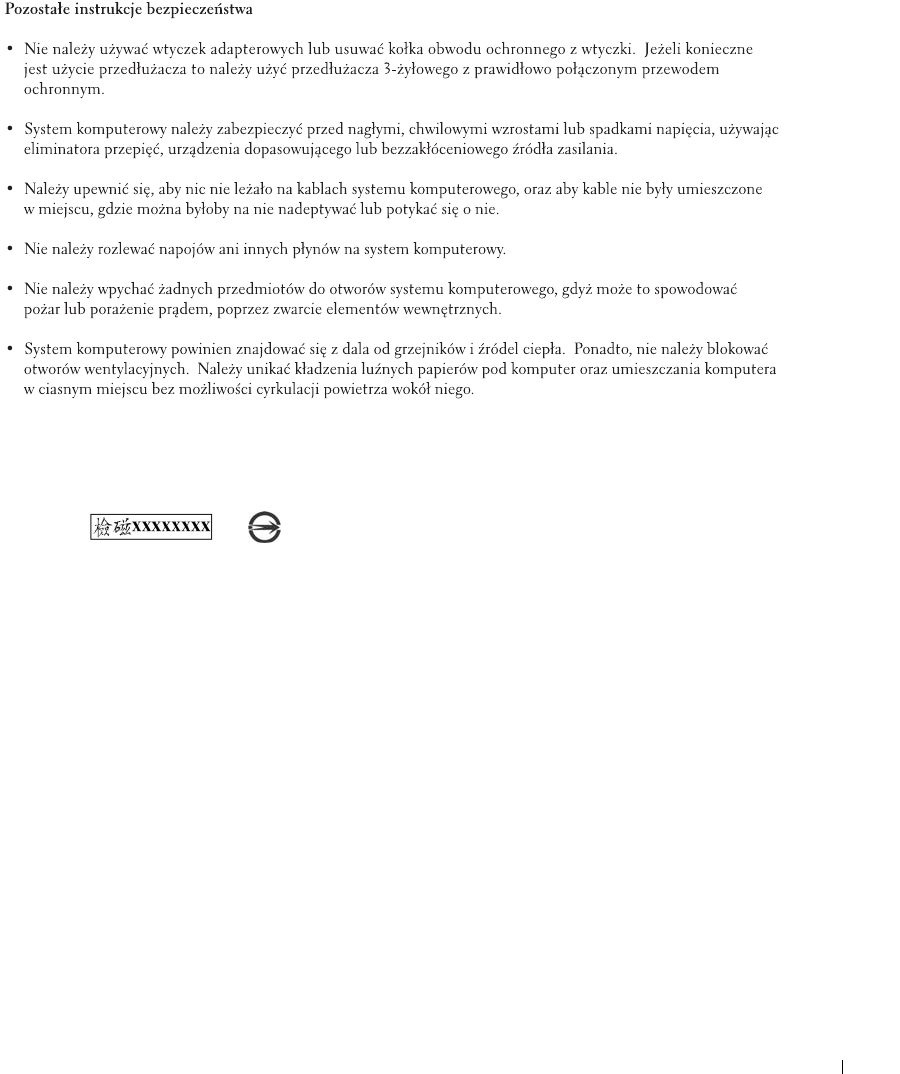
221
BSMI Notice (Taiwan Only)
If you find a or mark on the regulatory label on the bottom, side, or back panel of your computer, the
following section is applicable:
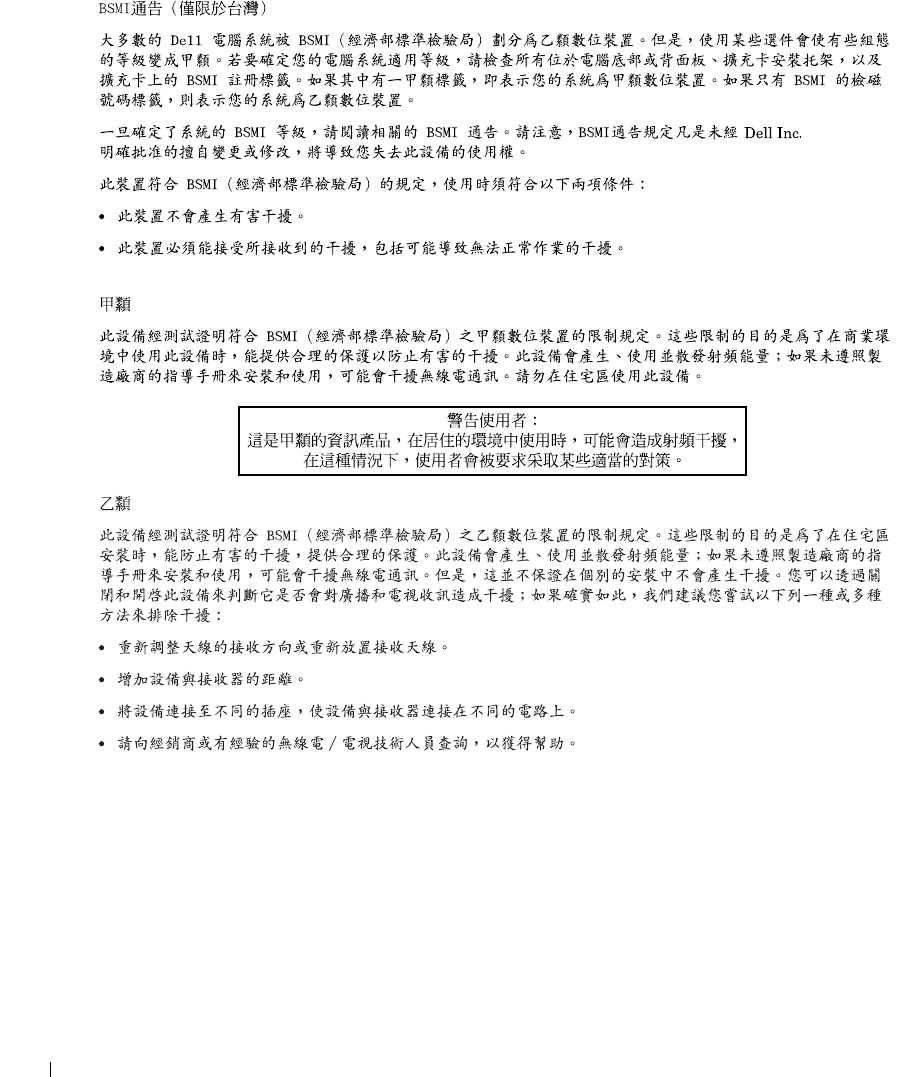
222
NOM Information (Mexico Only)
COMMENT: The model number, supply voltage, frequency, and current consumption figures
may vary from computer to computer. Check with Product Safety Engineering to determine the
information for your computer. Also ask whether you should use dashes or slashes for the
"Supply voltage" and "Frequency" numbers.
The following information is provided on the device(s) described in this document in compliance with the requirements of the official
Mexican standards (NOM):
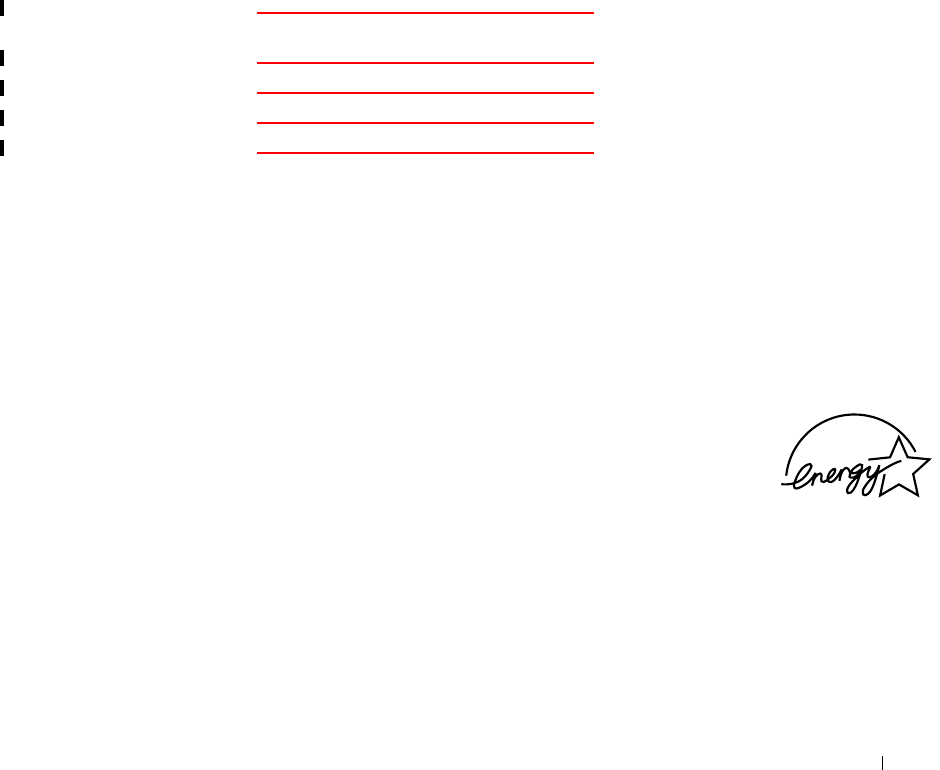
223
ENERGY STAR® Compliance
Certain configurations of Dell computers comply with the requirements set forth by the Environmental Protection Agency (EPA) for
energy-efficient computers. If the front panel of your computer bears the ENERGY STAR® Emblem, your original configuration
complies with these requirements and all ENERGY STAR® power management features of the computer are enabled.
NOTE: Any Dell computer bearing the ENERGY STAR® Emblem is certified to comply with EPA ENERGY STAR® requirements as configured
when shipped by Dell. Any changes you make to this configuration (such as installing additional expansion cards or drives) may increase the
computer’s power consumption beyond the limits set by the EPA's ENERGY STAR® Computers program.
ENERGY STAR® Emblem
The EPA's ENERGY STAR® Computers program is a joint effort between the EPA and computer
manufacturers to reduce air pollution by promoting energy-efficient computer products. The EPA estimates
that use of ENERGY STAR® computer products can save computer users up to two billion dollars annually in
electricity costs. In turn, this reduction in electricity usage can reduce emissions of carbon dioxide, the gas
primarily responsible for the greenhouse effect, and sulfur dioxide and nitrogen oxides, the primary causes of acid rain.
You can also help reduce electricity usage and its side effects by turning off your computer when it is not in use for extended periods of
time, particularly at night and on weekends.
Exporter: Dell Inc.
One Dell Way
Round Rock, TX 78682
Importer: Dell Computer de México, S.A. de C.V.
Paseo de la Reforma 2620 - 11° Piso
Col. Lomas Altas
11950 México, D.F.
Ship to: Dell Computer de México, S.A. de C.V.
al Cuidado de Kuehne & Nagel de México S. de R.L.
Avenida Soles No. 55
Col. Peñon de los Baños
15520 México, D.F.
Model number:
Supply voltage: xxInsert correct info here, such as: 100/240
VAC
Frequency: xxInsert correct info here, such as: 50/60 Hz
Current Consumption: xxInsert correct info here, such as: 1.5 A
Output voltage: xxInsert correct info here, such as: 20 VDC
Output current: xxInsert correct info here, such as: 3.5 A

224

